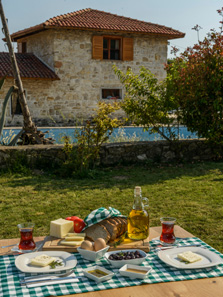Beach Brews: A Guide to Mediterranean Tea

Hibiscus
Call it the Kool-Aid blossom—or sangria flower, if you're over 21. Refreshing, full of vitamin C and helps maintain fluid balance. Vitamin C is one of those peppy little compounds that gives you energy without caffeine, hence the zing on the aftertaste. Juicy hibiscus petals make a great iced tea. Left to oversteep, it brews up tart and punchy. A common tropical flower, hibiscus also flourishes in temperate climates, making it easy to grow around the world for tea.
Peppermint
Specifically peppermint. Not spearmint, not wintergreen. In the cup, you'll notice that peppermint has a sharper taste than the others. This comes from a greater menthol content—the same compound found in cough drops and IcyHot—which registers as a super kick to the senses as it stimulates circulation, allowing tight muscles to relax in response. If you've just spent the day running on that glorious Mediterranean beach, this comes in handy. The best peppermint teas have a slightly chocolate undertone, like Peppermint Patties.
Chamomile
Grandma's remedy for sleepless nights, this tea is essential during flu season. Children love the honey-tinged flavor at the end of a sip. Egyptian chamomile is especially sweet, while the Balkan varietal brings forth mellower meadows in the cup. Do not drink this when you're out late kafana-hopping. Please. Save it for an hour before bed, with a good book, to sooth the soccer—I mean, futbal—shouts echoing in your head.
Linden
Chamomile's softer sister. Little known in the United States, linden is popular in Europe as both a pleasure drink and medicinal plant. Known to soothe clinical anxiety and relieve depression, it calmly brings your meal or evening to a close. Like chamomile, this is not a tea for partying. Instead, see if the licorice-mint flavor pairs up well with slow guitar jams at the end of the night.
Now get up, and start packing for the beach! The sun won't last forever, and there's a cup waiting for you under the olive trees.
